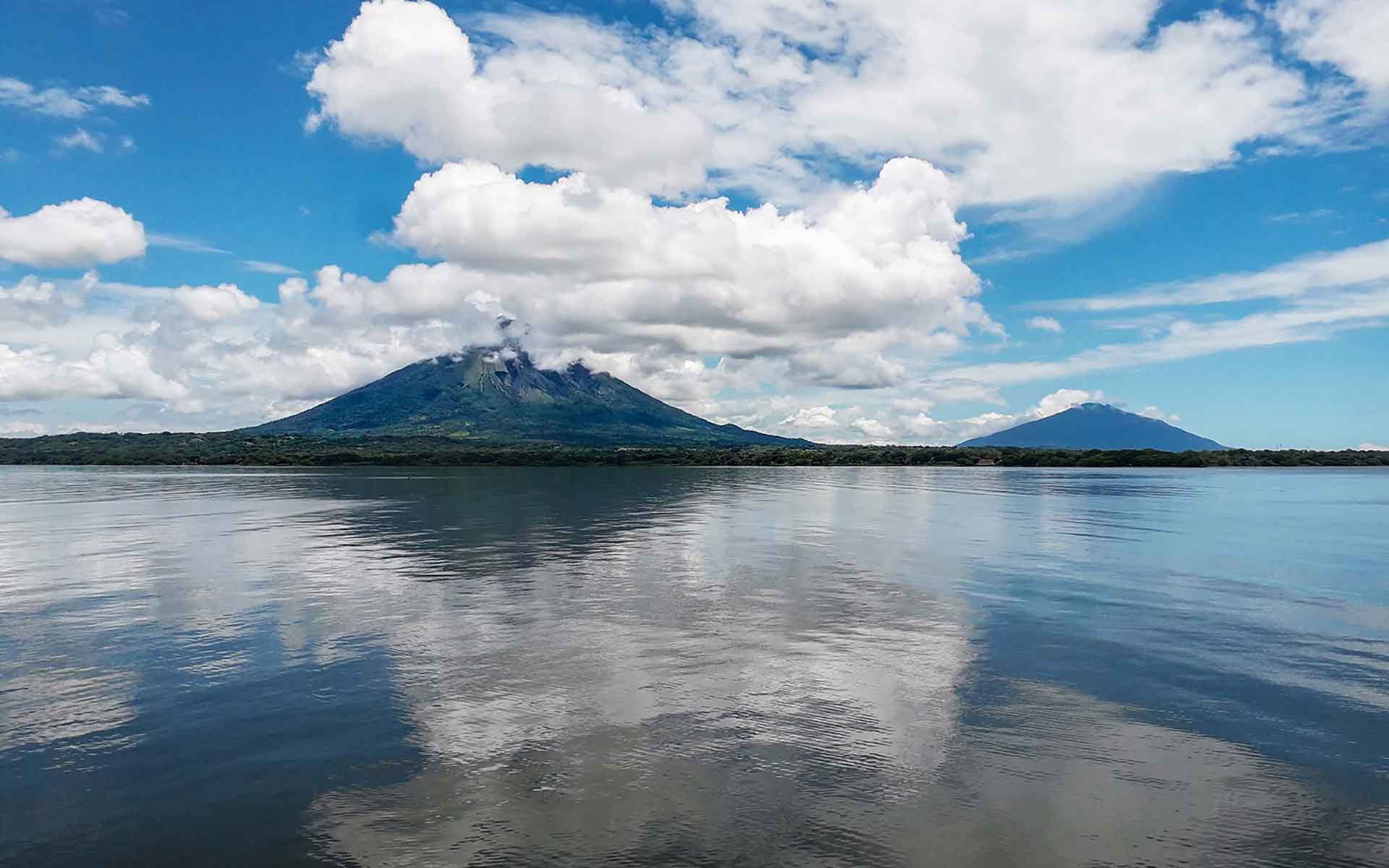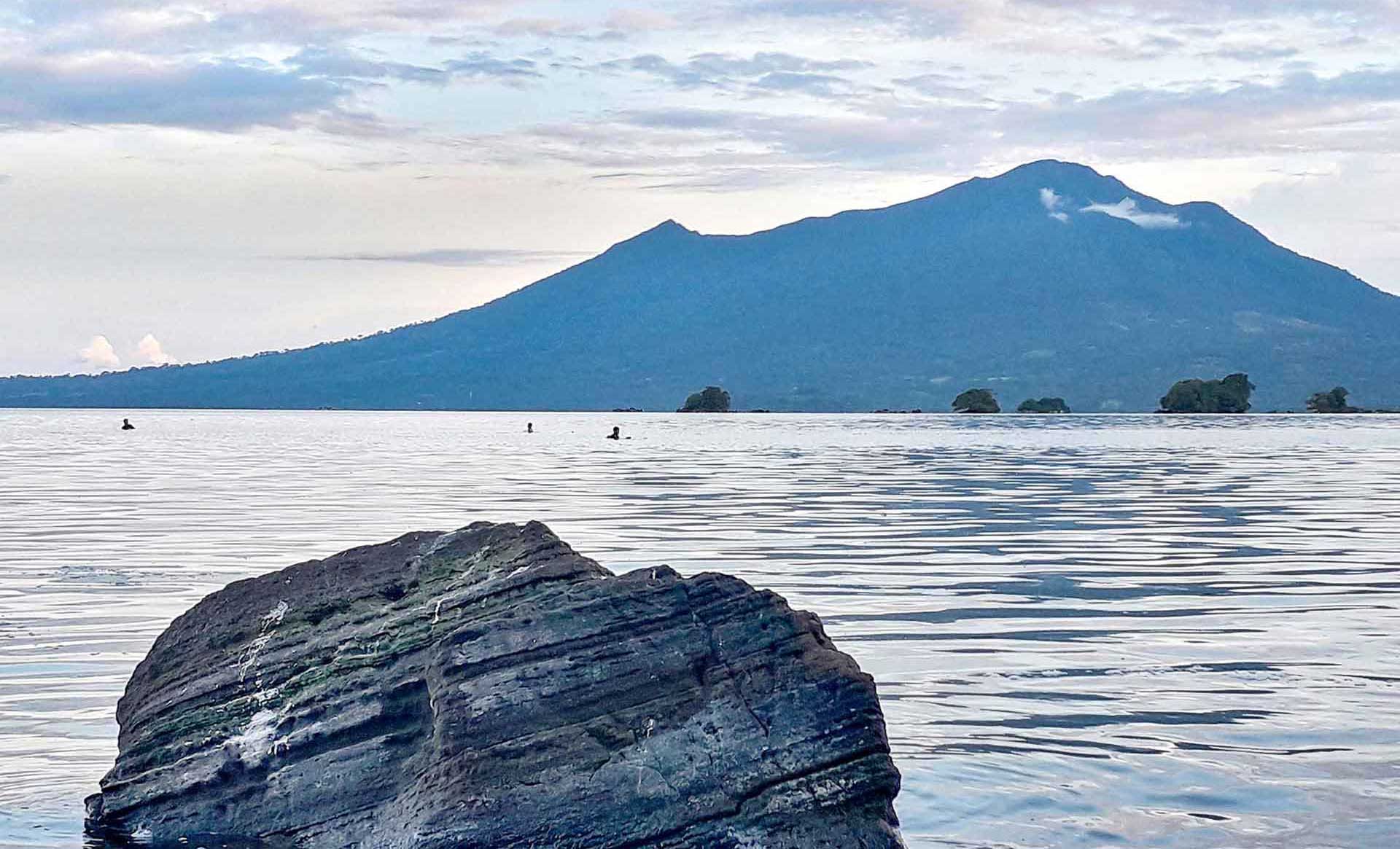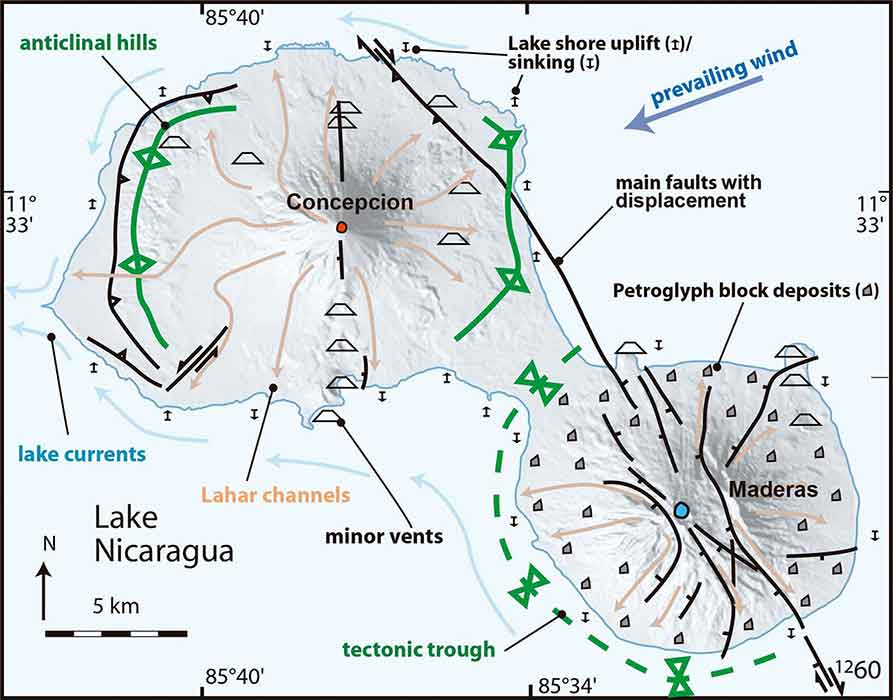La Isla de Ometepe Quaternary volcanoes in the Lake Nicaragua
NICARAGUA

The different shapes of Concepcion and Maderas: Maderas plunges directly into a trough, but Concepcion is ringed by anticlinal hills, clearly seen on the left.
Geological Period
Quaternary
Main geological interest
Volcanology
Tectonics
Location
Lake Nicaragua, Nicaragua.
11°30’10.0″N, 85°34’15.0″W
The different shapes of Concepcion and Maderas: Maderas plunges directly into a trough, but Concepcion is ringed by anticlinal hills, clearly seen on the left.
A type example of volcano spreading and volcano-tectonic interactions in the volcanic arc sedimentary basin of Lake Nicaragua.
Isla de Ometepe is a globally significant site for interactions between plate tectonics, gravity tectonics, and magmatic – volcanic process, all combined with the external environment, which has fashioned human culture and resilience. The island’s geomorphology, seen as a tectonic and volcanic landscape, allows the interface between geosphere, biosphere, archaeology, history and present day activity to be understood. The island’s location in an inland sea, which has been the point of concentration of cultures for thousands of years, has attracted scientists for intensive and ongoing research.
- Geological description
Isla de Ometepe, Lake Nicaragua is a landscape of ongoing interactions between gravity, tectonics and volcanism in a lacustrine environment on a convergent plate boundary (Borgia and van Wyk de Vries 2003; Saballos et al., 2013). The island has two stratovolcanoes, Concepción and Maderas, displaying active geodynamics interacting with environment and biosphere.
Maderas (Mathieu et al., 2011; Kapelanczyk et al., 2012) is long dormant and is cut by impressive faults reflecting strike-slip regional and gravity tectonics. An abundance of lahar boulders have inspired hundreds of pre-colombian petroglyph carvings.
Concepcion is an active cone, fashioned by historical eruptions, and is surrounded by uplifted pre-volcano lake sediments to heights of over 200 m, in a range of rolling anticlinal hills. Regional tectonics, magmatic pressure and gravitational stresses have created folds and faults. A complete eruptive sequence of the whole volcano history is exposed. Pre-colombian artifacts are found within the tephra sequence (Haberland 1986). The 40,000 inhabitants also come together in an impressive example of community resilience to disaster risk. Isla de Ometepe reflects the conjunction of multiple processes in a volcanic arc setting (Funk et al., 2009), geologically combining plate tectonics, gravity tectonics and volcanism surface processes in one perfect figure of eight.
- Scientific research and tradition
Isla de Ometepe has been continually in scientific literature since the 19th Century. Concepcion volcano has been intensively studied, and Maderas volcano is one of the best dated volcanoes in Central America. Both are used as type examples of volcano spreading and of arc volcano-tectonic interactions.
- Reference
Borgia, A. and van Wyk de Vries, B. (2003) ‘The volcano-tectonic evolution of Concepción, Nicaragua’, Bulletin of Volcanology, 65, pp. 248–266. Available at: https://doi.org/10.1007/s00445-002-0256-8.
Funk, J., Mcintosh, K. and Stephens, J. (2009) ‘Cenozoic tectonics of the Nicaraguan depression, Nicaragua, and Median Trough, El Salvador, based on seismic-reflection profiling and remote-sensing data’, Geological Society of America Bulletin, 121, pp. 1491–1521. Available at: https://doi.org/10.1130/B26428.1.
Haberland, W. (1986) ‘Settlement patterns and cultural history of Omettepe Island, Nicaragua: A preliminary sketch’, Journal of the Seward Anthropological Society, 14((1982-1983)), pp. 369–386.
Kapelanczyk, L., Rose, W.I. and Jicha, B. (2012) ‘An eruptive history of Maderas volcano using new 40Ar/39Ar ages and geochemical analyses’, Bulletin of Volcanology, 74(9), pp. 2007–2021. Available at: https://doi.org/10.1007/s00445-012-0644-7.
Mathieu, L. et al. (2011) ‘The interaction between volcanoes and strike-slip, transtensional and transpressional fault zones: Analogue models and natural examples’, Journal of Structural Geology, 33(5), pp. 898–906. Available at: https://doi.org/10.1016/j.jsg.2011.03.003.
Saballos, J.A. et al. (2013) ‘Gravity and geodesy of Concepción Volcano, Nicaragua’. Available at: https://doi.org/10.1130/2013.2498(05).
- Author(s)
Eveling Espinoza
Dirección de Vulcanología, Dirección General de Geología y Geofísica – INETER, Instituto Nicaragüense de Estudios Territoriales, Managua, Nicaragua.
Armando Saballos
INETER, Instituto Nicaragüense de Estudios Territoriales, Managua, Nicaragua
David Chavarria
INETER, Instituto Nicaragüense de Estudios Territoriales, Managua, Nicaragua
William Martinez
INETER, Instituto Nicaragüense de Estudios Territoriales, Managua, Nicaragua
Martha Navarro
Consultora Independiente. Presidenta de Cooperativa de Mujeres Senderos del Cosiguina
Benjamin van Wyk de Vries
Université Clermont Auvergne, Laboratoire Magmas et Volcans, OPGC, CNRS et IRD, Clermont Ferrand, France


